back to jew's harp types
to the contents
forward to tones and pitches
|
back to jew's harp types |
to the contents |
forward to tones and pitches |
There is no such thing as a single and universally accepted playing
technique. Therefore the techniques described below are suggestions meant
to be altered and improved just as you like. The figures and sound
examples present bow-shaped jew's harps, but the techniques described are
valid for all jew's harps.
There are numerous ways of holding and plucking the jew's harp. See the gallery of pictures from jew's harp musicians to
get an impression. To find the best technique for yourself, it is a good
idea to study, copy and try out different ways of playing.
In the following my suggestions:
How to hold the jew's harp
With one hand the jew's harp is put against the slightly opened lips in
such a way, that the reed can swing through them (figure 1, 2). Bow-shaped
jew's harps have to touch the opened incisors also (see quickstart).
The end of the frame (lamellate jew's harps, figure 2 right) or the reed
(bow-shaped ones, figure 2 left) is plucked with the fingers of the other
hand. It produces the fundamental note (or prime tone) of the instrument
that is heard continuously while playing. The oral cavity and other
resonance chambers amplify different overtones of this fundamental note,
thus producing the tone colours and pitches of your playing. Read more
about this subject in the chapter tones and
pitches.
figure 1
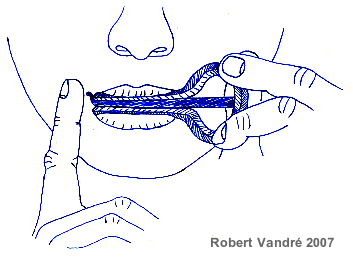
figure 2
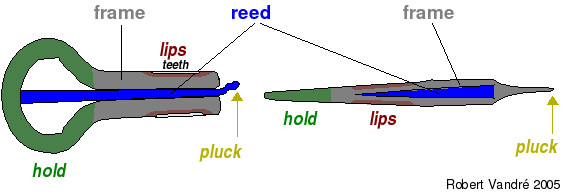
|
How to Pluck |
By plucking the reed the fingers play separated tones, producing tone lengths and rhythm. The reed may be plucked by one stretched finger, picking the reed from below and away from the mouth (figure 1 und 3 A, solid arrow). The finger may also pick the reed in the opposite direction (figure 3 A, broken arrow). Thus plucked back and forth, melodies with fast rhythm patterns can be played, as in sound example 1 (158 KB).
figure 3
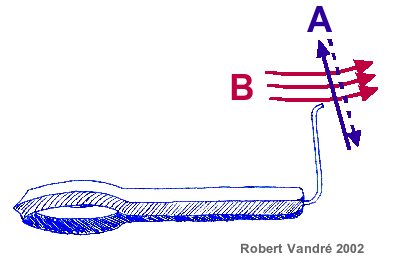
|
Tremolo: regular and rapid repetition of a single note |
If the palm of the plucking hand is turned towards the mouth (figure 4), forefinger, middle-finger and ring-finger can pick the reed alternately and in quick succession, somewhat alike the way a flamenco-guitar-player works the guitar strings (figure 3 B). The effect can be heard in sound example 2 (299 KB). This technique needs a lot of practice before the plucking gets regular and the reed is prevented from hitting the frame of the jew's harp. To keep the hand still and only the fingers moving, the thump may support the hand on the cheek bone (figure 4).
figure 4
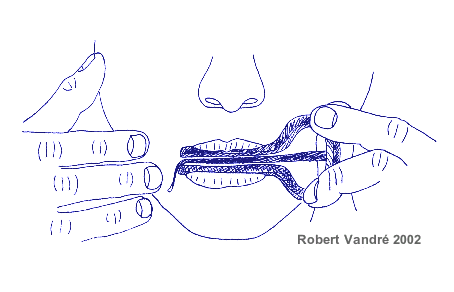
|
Other Finger Techniques |
The musician and video artist Vladiswar
Nadishana (see gallery) invented the
following techniques, producing vibrato and a mordent. To produce the vibrato
the reed is plucked by one stretched finger towards the mouth. Continuing
its movement, the finger knocks several times gently on the lips. At each
knock the amplitude and pitch of the jew's harp sound is slightly raised
(left side of figure 5, and sound example 3,
144 kB).
Mordent: The jew's harp is held between thumb, index finger and
middle finger like on the right side of figure 5. Now the ring finger nail
can briefly and gently touch the newly plucked, vibrating reed. By this
the pitch of the fundamental note is raised for an instant, producing an
upper or inverted mordent (sound example
4, 276 kB).
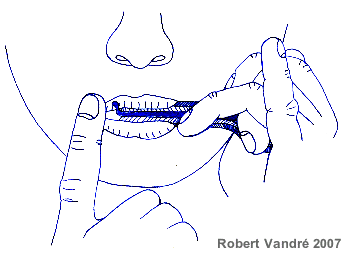
The finger-capodastro is another finger
technique: The reed of the jew's harp can be pinched between thumb and
forefinger or middle finger of the hand holding the jew's harp frame. The
basic tone is muted, and it gets a higher pitch, like in sound
example 5 (144 KB).
|
Articulation by Breathing |
Beyond holding the frame and plucking the reed, almost everything in
playing the jew's harp happens inside your mouth and throat, or is done by
the diaphragm, by breathing: Separated, articulated tones can be produced
by short breaths. When breathing in and out, the air stream amplifies the
fundamental note. In sound example 6 (173
KB) the jew's harp is plucked regularly. By breathing rasping sounds are
produced between the plucks.
Articulation with the Tongue
A succession of tones can be "pronounced" by the tongue, alike
articulation on the recorder or flute. When playing the recorder, the
tongue interrupts the air stream. With the jew's harp, no air stream is
needed. In this case the tongue opens and closes the oral cavity, allowing
and interrupting resonance. With or without air stream, the technique is
very alike. For slow melodies I suggest to open and close the cavity with
the tongue just behind the upper incisors, like pronouncing de de de.
For quick successions of tones you may express doodle doodle doodle,
using a swinging move of the tongue on the palate. However, flute players
use de ge de ge deg. In sound
example 7 (155 KB) the harp is again plucked regularly. In between
the plucks articulation is done by expressing de de de, doodle
doodle doodle and doodle de doodle de doodle. This technique
is easy and can be played very fast. Nevertheless it is rarely heard on
jew's harp recordings.
Staccato
I combined rapid picking with one finger like in figure 4 A with
articulation by the tongue, like pronouncing det
det dedledet to produce short, detached notes: staccato (sound
example 8, 350 kB)
Many playing techniques produce sound effects that influence both melody
and rhythm. The number of possible sound effects may be unlimited. It is
worth just to try out and discover ever new effects. Especially the tongue
is a very talented organ. In the following some suggestions.
An interesting effect that can be used for articulation originates from
the voice organ: The voice chink (glottis) is the opening that
regulates the flow of air through the oral cords (figure
6 in tones and pitches). When
closed, the resonance is altered in such a way that in addition to the
"normal" overtones deeper overtones are amplified. Two overtones can be
heard simultaneously and influenced independent of each other. To achieve
this, the voice chink has to be closed. This is the same action that is
used when talking to pronounce a single vowel: "What? #I don't get this."
At the # the chink is closed for an instant to pronounce the vowel "I".
When coughing it is the voice chink that holds back and suddenly releases
the breath. In sound
example 9 (235 KB) a melody is heard. Than the chink is closed and
opened repeatedly and the additional tones of the altered resonance are
heard as well as the opening and closure of the glottis.
Nasal and oral cavity are
important resonance chambers of the jew's harp. Movements in these
cavities directly affect the sound of the harp. The nasal cavity can be
closed against the resonace chambers of bronchial tubes and chest by the
soft palate (figure 4 in tones and pitches). It
is this "closing" of the nose you may use if you talk and want to sound
like you catched cold. The connection between oral cavity and air tube is
closed by the tongue when speaking "ng" like in the suffix "-ing":
Silently pronouncing "ing ing ing ing" while playing the jew's harp
results in an interesting effect that is heard in the first part of sound
example
10 (160 KB). The second part illustrates another tongue
effect: The middle part of the tongue is put against the upper
molar teeth, and the tip touches and leaves the palate - like speaking "ne
ne ne".
To produce a percussion effect you may hold the jew's harp against your pursed
lips. The sound is muted. If the lips are closed, the reed claps
against them. By parting the lips just after the clap you get the effect
of sound example 11 (259 KB).
Melody Notes
On the jew's harp different pitches are produced by the same movements of
the tongue used in speech when pronouncing the different vowels. Use the
following exercise to try this out: Play on your jew's harp and listen to
the fundamental note, the pitch of the reed. Now without jew's harp sing
this note. While singing constantly, form the vowel u
(like in "boot"), than change slowly to i
(like in "reed") and back again to u.
Listen to the changing sound: You hear the overtones or harmonics of your
voice, from deeper to higher notes and back again. Now play the jew's harp
again and use the same movements of the tongue as before. Together with
the fundamental note you can hear the changing pitches and resonances of
the second formant region (more explanations in Tones
and Pitches: Resonances).
A second way to imagine the notes, that is, the resonances of the second
formant region is quite simple: Whistle a tune. Again you use and hear the
variable sound of the oral cavity that corresponds to the second formant
region. The only difference between whistling tunes and playing them on
the jew's harp is the way the sound is generated. The movements of the
tongue, influencing the sound of the oral cavity, are equal and produce
the same pitches.
Deep accompanying notes
It is more difficult to imagine and control the deeper resonances of the
first formant region, formed in the throat. These resonances can be used
to play accompanying notes. You can hear the effect on the
title "Kein schöner Land" (see music):
The first verse is played without, the second with deeper accompanying
notes. You may give it a try as follows (don't worry if it does not work):
Play a constant note on the jew's harp, e.g. an octave of the fundamental
reed note. While playing and without voice, form the succession of the
vowals u - o (like in "law") - a (like "father") - o - u. The note played
shal remain constant. In speech the vowels u and o are formed by movements
in the throat an by pursuing the lips. Here the lips are not moved, they
stay on the jew's harp frame. The sounds of the deeper notes of the first
formant are formed by movments in the throat.
The deep notes are especially clear when you breath softly while playing,
or when you close the voice chink (see above: Sound
effects and sound example 9
(235 KB)).
In this way tunes can be played using the overtones of the fundamental
note provided by the jew's harp reed (see natural
harmonic
row). At the higher part of the row the overtones are so near each
other that practically every melody can be played irrespective of the
fundamental note. In the lower part of the row the distance between the
overtones is more pronounced and not every note can be played. As the
fundamental note is heard all the time, a melody played with the overtones
will sound best if the fundamental note fits in. For example, a jew's harp
tuned C (that is, C is the fundamental note) will be good to play melodies
on the C major (as well as minor) key. The basic tone reminds on the drone
of bagpipes and medieval stringed instruments, as illustrated in a section
of La Quarte Estampie Real in sound example
12 (209 KB).
To play printed music, you have to recognize the melody, since unlike on a
piano, the notes of a melody cannot be produced mechanically. The playing
of melodies functions like whistling or singing: They are formed freely
inside the mouth/throat.
|
How to play without contact to the teeth on bow-shaped jew's harps |
To spare your teeth, I recommend to attach the harps to a piece of wood
or a piece of metal tube (figure 6). Fixed to an object of some weight,
the jew's harp can be played without contact to the teeth. You just have
to put the frame against your lips. The sound is the same as normal (only
the player himself/herself will hear the sound differently, as it is
transported to the ears via the skull when using the teeth). Playing
without teeth is very comfortable, especially when playing or exercising a
lot.
With such a weight attached to the jew's harp, the lips can be opend and
closed while playing, like in sound example 13
(221 kB).
A good sound without teeth is achieved by a weight of 200 to 300 g that is
20 to 30 cm long. The size is essential for the functioning of the weight:
The reed vibrates in a rotating manner (figure 6, right, blue arrow). The
weight has to function as a lever-arm against the rotation (red arrow).
In figure 6, the jew's harp is clamped between two peaces of wood and
attached to the metal tube by a lace. The lace goes through the tube and
is tied to a wooden pin. By turning the pin, the lace is twisted and
tightened.
The company Dan Moi has adopted my idea and offers the jew's harp weight
as accessory (see links).
figure 6
|
|
|
| |
|
|
| |
to the top |
|
|
back to jew's harp types |
to the contents |
forward to tones and pitches |